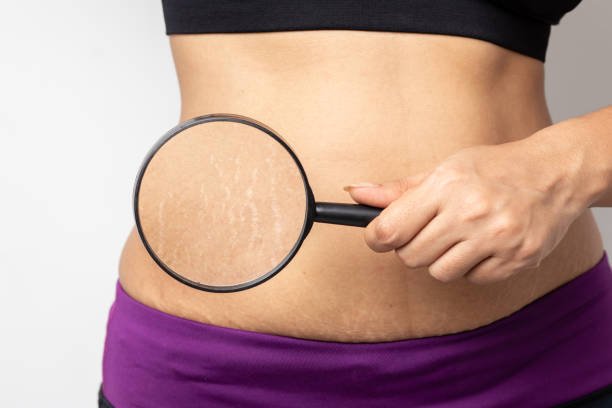How To Remove Stretch Marks On belly At Home? What You Need to Know
Stretch marks, also known as striae, happen when your skin changes shape quickly because of things like growing or gaining weight. They don’t mean something is wrong with your health.
People of any gender can get stretch marks, but they usually show up most during pregnancy or puberty.
At first, a stretch mark looks like a thin red or purple line that feels different from the skin around it. Most of the time, they get lighter on their own as time goes on.
They might not stand out as much when they’ve faded. Faded stretch marks are usually a bit lighter than your regular skin and a little shiny, like a scar.
Right now, there’s no magic ingredient that can make stretch marks disappear completely. But there are some things you can try at home that might help make them less noticeable and fade faster.
1. Vitamin A: The Skin’s Helper
In skincare, they call Vitamin A “retinoid.” It’s like a secret weapon for making your skin look smoother and younger. You’ll find it in many creams you can buy without a prescription.
Some research from 2015 looked at a strong form of Vitamin A called tretinoin. A study from 1996 also found that tretinoin made stretch marks look smaller and less noticeable.
But we need more recent and bigger studies to really know how well tretinoin works for stretch marks. And a heads up, Vitamin A stuff can sometimes make your skin irritated. So, if you decide to use it, follow the instructions carefully.
If you’re pregnant, nursing, or trying to get pregnant, it’s best to skip Vitamin A products. They might not be safe for you during these times.
2. Hyaluronic Acid: The Skin’s Hydrator
Hyaluronic acid is like a super moisturizer for your skin. They put it in creams, lotions, and serums.
When you see stretch marks, it means your skin isn’t as stretchy as it used to be. One reason is that collagen, which makes your skin strong, isn’t doing its job as well.
A study suggested that hyaluronic acid could help your skin be more elastic. Some 2017 research even said it might make stretch marks look better. But we still need more studies to be sure.
To give it a shot, just put a hyaluronic acid product on your stretch marks every day.
3. Sugar: The Sweet Scrub
Sugar is a natural exfoliator. It’s like those little scrubby crystals that gently remove dead skin, leaving you feeling softer.
If you’ve heard of microdermabrasion, it’s a proven way to make stretch marks fade, but it’s usually done by a dermatologist. So, this sugar scrub is a home remedy that’s worth trying. You might already have sugar and oil at home.
Here’s how to do it:
- Mix 1/2 cup of sugar with a softening oil like almond or coconut oil. You want it to look like wet beach sand, so add the oil slowly.
- Gently rub this mixture on the area with stretch marks 2 or 3 times a week in the shower or bath. Rinse with warm water.
Make small batches as you need them. You can store it for a little while, but if it smells or looks weird, make a new batch.
4. Aloe Vera: The Natural Soother
Aloe vera has been a skin helper for a long time. It’s like a natural balm that can soothe and moisturize your skin.
In 2018, research found that aloe vera helps skin heal from burns and wounds. Because stretch marks are like scars from damaged skin, aloe vera might help prevent them or make them fade.
We don’t have a ton of proof that aloe vera is a surefire cure for stretch marks, but it’s gentle and can make your skin softer and healthier. Just use pure aloe vera from a plant or a product you can buy, and apply it to your stretch marks every day after you shower.
5. Centella Asiatica: The Korean Beauty Secret
Centella asiatica is a fancy name, but it’s a cool ingredient found in Korean beauty products. People sometimes use these “cica creams” to help scars or soothe sensitive skin.
Centella can calm inflammation and boost collagen production. In 2015, researchers said creams with centella might help prevent stretch marks in pregnant folks and make them look better. But we still need more proof.
6. Coconut Oil: The Skin’s Protector
Virgin coconut oil is pretty awesome for your skin. It helps keep your skin’s protective barrier strong.
We don’t have a lot of proof that coconut oil is a stretch mark miracle worker, though. Other oils like olive oil, almond oil, and cocoa butter haven’t shown much improvement either.
But here’s the thing: gently massaging any oil onto your skin might prevent stretch marks, according to research from 2015. So, if you like, you can gently massage your stretch marks with coconut oil every day. Just make sure you’re not allergic to it.
Remember, though, sometimes even natural stuff can cause skin allergies or sensitivities. So, if your skin doesn’t like it, stop using it.
Signs and Symptoms
Before stretch marks show up, your skin might seem thin and pink. It could even feel a bit irritated or itchy.
At the beginning, these marks look like wrinkly, raised lines. They can be red, purple, pink, reddish-brown, or dark brown, depending on your skin color. Over time, they become flatter and usually turn silvery in color.
Stretch marks might become less noticeable, but this often takes a long time.
Causes and Risk Factors
Stretch marks can happen when your skin stretches a lot or shrinks suddenly. Here are some common reasons for skin stretching:
- Pregnancy: Many pregnant women (between 50 and 90 percent) get stretch marks during or after childbirth because their belly grows quickly.
- Puberty: Young people going through puberty often grow rapidly, which can lead to stretch marks.
- Rapid weight gain: If you gain a lot of weight in a short time, it can cause stretch marks.
- Medical conditions: Some health conditions like Marfan syndrome and Cushing’s syndrome can make you more likely to get stretch marks. Marfan syndrome can make your skin less elastic, while Cushing’s syndrome can cause rapid weight gain and fragile skin.
- Corticosteroid use: Using corticosteroid creams or lotions for a long time can reduce the collagen in your skin. Collagen is what makes your skin strong, and less of it can increase your chances of getting stretch marks.
Our skin has three main layers. Stretch marks happen in the middle layer called the dermis when the connective tissue gets stretched too much. This usually happens when your skin grows or shrinks really quickly.
As your body grows slowly, the fibers in the dermis slowly stretch to keep up. But fast growth makes the dermis tear, and that’s when deeper layers of skin become visible. This is what creates stretch marks.
Over time, stretch marks change and look silvery, white, or shiny because you start seeing the fat beneath your skin instead of the usual blood vessels.
They tend to form more and become worse when there’s a lot of cortisone (or when you apply cortisone to your skin). Cortisol, which is a stress hormone, turns into cortisone, and that can weaken the elastic fibers in your skin.
Risk Factors
Certain things make you more likely to get stretch marks, although more research is needed to be sure of all the causes. These risk factors include:
- Family history: If others in your family have had stretch marks, you might be more prone to them too.
- Chronic diseases: Some long-term illnesses could increase your chances of getting stretch marks.
- Body mass index (BMI) before pregnancy: If you’re overweight before getting pregnant, you might have a higher risk.
- Baby’s birthweight: For pregnant women, the baby’s size matters. Having a larger baby might increase your risk of getting stretch marks.
Doctors can easily tell if you have stretch marks just by looking at your skin and asking about your medical history.
Remember, stretch marks are usually harmless and don’t cause health problems. In rare cases, they might be a sign of an underlying issue that needs treatment or monitoring.
Treating and Preventing Stretch Marks:
When it comes to treating stretch marks, it’s important to understand that it can be pricey, and there’s no guarantee it will work. Usually, insurance won’t cover the cost because stretch marks are considered a cosmetic concern.
People have suggested using creams, gels, lotions, and even cosmetic surgery to treat stretch marks, but there’s not much solid proof that these methods are super effective. Plus, these treatments may not work well for all skin types.
The good news is that stretch marks often naturally fade away with time, and they become less noticeable. If you’re a new mom and got stretch marks during pregnancy, they typically become less obvious about 6 to 12 months after giving birth. In the meantime, makeup can help cover them up if they bother you.
Creams, Oils, and Other Skin Stuff
Now, there’s some talk about using creams, oils, and other things on your skin to help with stretch marks, but the science isn’t super clear on this. Some studies compared these treatments to doing nothing at all or using stuff with no active ingredients, and they didn’t find a big difference. So, it’s a bit up in the air whether these products really help.
Preventing Stretch Marks
Preventing stretch marks isn’t always possible, but here are some things you can try to reduce the chances:
- Keep a healthy weight: Maintaining a steady weight can help.
- Say no to yo-yo dieting: Avoid those extreme diet ups and downs.
- Eat well: A balanced diet with vitamins and minerals, especially vitamins A and C, zinc, and silicon, can be good for your skin.
- Pregnancy: If you’re expecting, try to gain weight slowly and gradually.
- Stay hydrated: Drinking enough water (about 6 to 8 glasses a day) can also be a good idea. Learn more…….How much water should you drink per day?
Remember, your body is unique, and stretch marks are a common part of life. Don’t stress too much about them, and focus on staying healthy and happy!
Keep in Mind
Stretch marks are super common. Many of us go through changes like growth spurts, weight ups and downs, and pregnancy, and that’s when stretch marks often show up.
While there’s no magic cure you can whip up at home, some creams and stuff you put on your skin can help keep it hydrated and kickstart the healing process. But here’s the thing: we still need more research to know for sure which treatments work best and for whom.
If you’re pregnant and want to treat stretch marks, it’s a good idea to talk to your doctor first to make sure it’s safe.
The good news is that almost all stretch marks fade with time, even if you don’t do anything about them. They usually don’t stay as noticeable as when they first pop up. So, don’t stress too much – your body’s got this!


